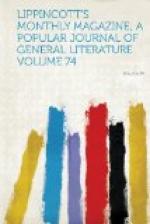and fellows of Corpus Christi College to the curacy
of St. Benet’s, Cambridge. Within a twelvemonth
after—namely, in 1631—HE made
his first appearance as an author. His Davia’s
Heinous Sin, Hearty Repentance, Heavy Punishment,
which came out in that year, was his sole adventure
of noteworthy compass as a versifier; and he certainly
testified his discretion in choosing thenceforward
to be satisfied with writing prose. A valuable
prebend attached to the Salisbury Cathedral was bestowed
on him at this time, near about which he is supposed
to have delivered, in discourses, his so-called Comment
on Ruth. Next we hear of him as rector of
Broadwindsor, where, probably, he composed his History
of the Holy War, published in 1639. His Holy
State was given to the world in 1642. Having
just before this removed to London under circumstances
which are involved in some obscurity, he was there
appointed lecturer to the Inns of Court and to the
Savoy Chapel. But trouble awaited him, as it
then awaited all other loyalists whom it had not overtaken
already, and 1643 found him a refugee at Oxford.
There he was warmly welcomed by the king and his adherents,
but on his imprudently daring to urge lenient counsels,
his moderation gave as much dissatisfaction to the
court party as it had previously given to the Parliamentarians,
and he fell into temporary disgrace. Nevertheless,
he suffered, at the hands of the anti-royalists, the
same spoliation which would have been visited on a
malignant of the extremest stamp. To fill up
the measure of his misfortune—as if it
were not enough that he should be deprived of his stated
means of livelihood—he was despoiled of
his library. For a while, also, his loyalty was
held, though without the slightest grounds, in considerable
suspicion. On coming to be better known, however,
he was restored to favor, and was enrolled among the
royal chaplains. If the doubts as to the sincerity
of his adhesion to Charles were ever actually thought
to have good foundation, they must have been dissipated
by his voluntarily exposing himself to danger, as he
did at one of the sieges of Basing House. Like
Isaac Barrow, he would at need have done duty militant
just as effectually with carnal weapons as with spiritual.
No longer required at Basing House, he repaired to
Oxford again, and then to Exeter, where he was nominated
chaplain to the princess Henrietta Anne. But
he held his new post for only a short period.
Leaving Exeter, he once more sought Oxford, and thence
went to London. Forbidden to preach there, he
retired to Northamptonshire, and then reappeared at
the metropolis, where he was sojourning in the memorable
year 1649. Becoming in that year curate of Waltham
Abbey, he enjoyed an interval of quietude while all
around him was turbulence. Yet he was soon in
London afresh, lecturer at various churches from 1651
till near the end of his life. In 1658 he was
appointed rector of St. Dunstan’s, Cranford,
but we read of him as subsequently journeying to The
Hague and to Salisbury, and as preaching at the Savoy
Chapel. It must have solaced his latter days
to reflect that he had survived to welcome the Restoration.
He died, from what is reasonably surmised to have
been typhus fever, on the 16th of August, 1661, and
lies buried in the chancel of the church to which
he last ministered, at Cranford, Surrey.




